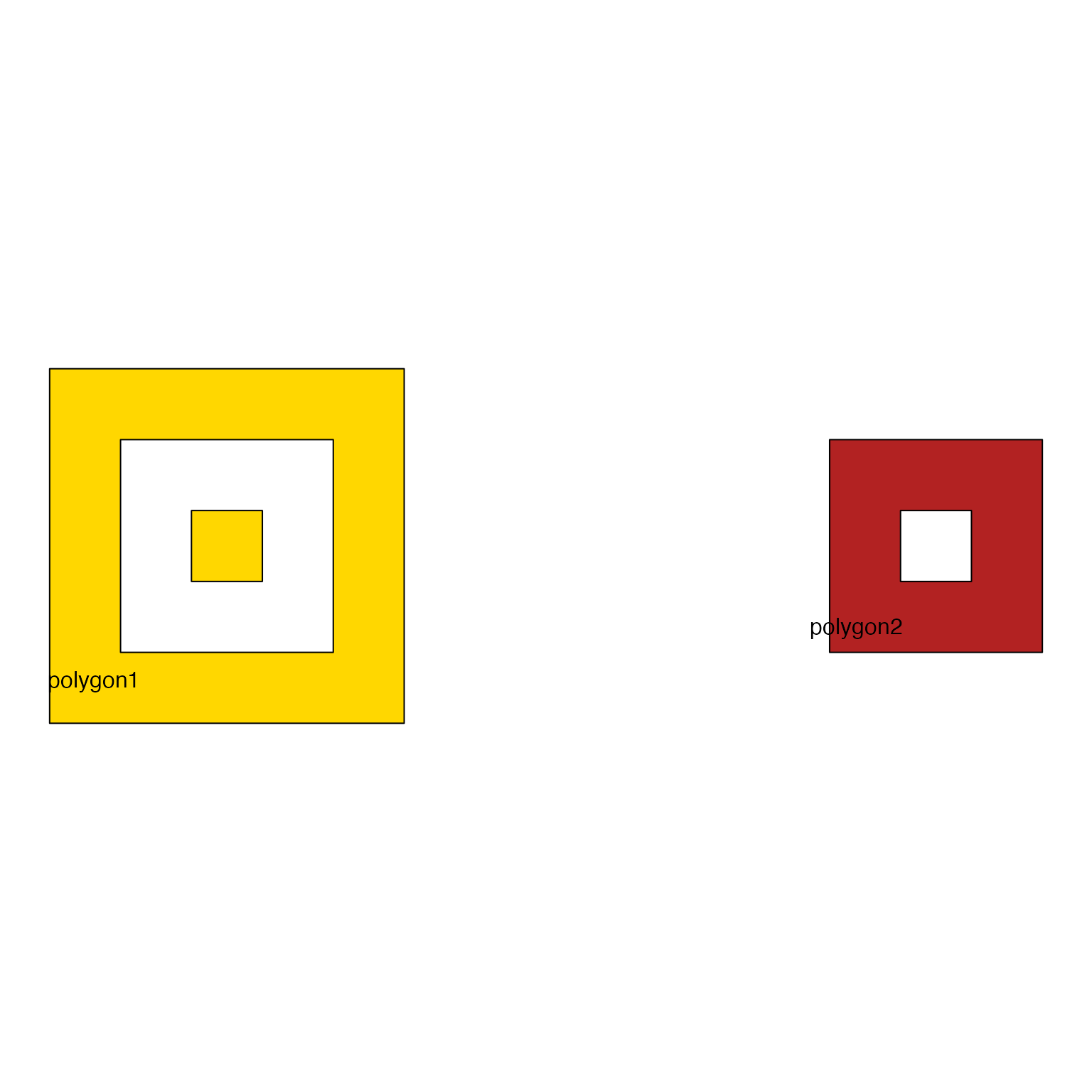Define orientation for each polygon, clockwise or counterclockwise
Source:R/JamPolygon.R
add_orientation_JamPolygon.RdDefine orientation for each polygon, clockwise or counterclockwise
Usage
add_orientation_JamPolygon(
jp,
flip_sign = 1,
include_holes = FALSE,
include_clockwise = FALSE,
include_parent = FALSE,
verbose = FALSE,
...
)Arguments
- jp
JamPolygon- flip_sign
integerto indicate whether the orientation should be flipped, inverting the meaning of all returned values. For example, clockwise polygons by default are considered "solid", and counter-clockwise are considered "holes", for the purpose of interpreting nested polygons. Whenflip_sign=-1it reverses these assumptions. This option is experimental and intended mainly for internal testing.- include_holes, include_clockwise, include_parent
logicalindicating whether to include additional columns to describe multi-part polygons. The clockwise direction is used to define the inner and outer edge of the border, usually defined as left or right, in relation to the direction the line is drawn. Nested multi-part polygons define interior holes, and are distinguished from adjacent polygons."polygon_clockwise": 1 clockwise, -1 counter-clockwise"polygon_holes": 1 is a solid polygon, -1 is a hole inside another polygon indicated with"polygon_parent"."polygon_parent": integer index used to indicate the parent polygon for nested multi-part polygons. The index will indicate itself, when the polygon is not nested inside another polygon.
- verbose
logicalindicating whether to print verbose output.- ...
additional arguments are ignored
Details
Todo:
When polygons are nested, which is intended to create holes inside one larger polygon, the hole should have its orientation flipped so that the border is drawn on the opposite side per its orientation. So the task is to determine whether a polygon is the hole of another polygon.
See also
Other JamPolygon:
JamPolygon-class,
[,JamPolygon-method,
area_JamPolygon(),
bbox_JamPolygon(),
buffer_JamPolygon(),
check_JamPolygon(),
eulerr_to_JamPolygon(),
farthest_point_JamPolygon(),
find_venn_overlaps_JamPolygon(),
has_point_in_JamPolygon(),
intersect_JamPolygon(),
label_fill_JamPolygon(),
label_outside_JamPolygon(),
label_segment_JamPolygon(),
labelr_JamPolygon(),
minus_JamPolygon(),
nearest_point_JamPolygon(),
nudge_JamPolygon(),
plot.JamPolygon(),
point_in_JamPolygon(),
polyclip_to_JamPolygon(),
polygon_circles(),
polygon_ellipses(),
sample_JamPolygon(),
split_JamPolygon(),
union_JamPolygon(),
update_JamPolygon()
Examples
df3 <- data.frame(name=c("polygon1", "polygon2"),
label=c("polygon1", "polygon2"),
x=I(list(
list(c(1, 6, 6, 1),
c(2, 5, 5, 2),
c(3, 4, 4, 3)),
list(#c(11, 16, 16, 11),
c(12, 15, 15, 12),
c(13, 14, 14, 13))
)),
y=I(list(
list(c(1, 1, 6, 6),
c(2, 2, 5, 5),
c(3, 3, 4, 4)),
list(#c(1, 1, 6, 6),
c(2, 2, 5, 5),
c(3, 3, 4, 4))
)),
fill=c("gold", "firebrick"))
jp3 <- new("JamPolygon", polygons=df3);
plot(jp3);
 add_orientation_JamPolygon(jp3,
include_holes=TRUE,
include_clockwise=TRUE,
include_parent=TRUE)
#> An object of class "JamPolygon"
#> Slot "polygons":
#> name label x y fill orientation
#> 1 polygon1 polygon1 c(1, 6, .... c(1, 1, .... gold 1, -1, 1
#> 2 polygon2 polygon2 c(12, 15.... c(2, 2, .... firebrick 1, -1
#> polygon_holes polygon_clockwise polygon_parent
#> 1 1, -1, 1 1, 1, 1 1, 1, 1
#> 2 1, -1 1, 1 1, 1
#>
add_orientation_JamPolygon(jp3,
include_holes=TRUE,
include_clockwise=TRUE,
include_parent=TRUE)
#> An object of class "JamPolygon"
#> Slot "polygons":
#> name label x y fill orientation
#> 1 polygon1 polygon1 c(1, 6, .... c(1, 1, .... gold 1, -1, 1
#> 2 polygon2 polygon2 c(12, 15.... c(2, 2, .... firebrick 1, -1
#> polygon_holes polygon_clockwise polygon_parent
#> 1 1, -1, 1 1, 1, 1 1, 1, 1
#> 2 1, -1 1, 1 1, 1
#>